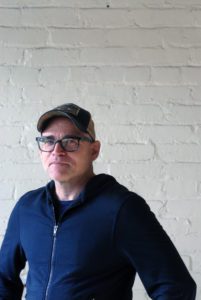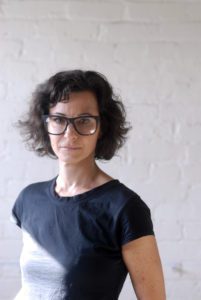Stable DC
By • November 12, 2018 0 1838

IN THIS D.C. ARTS SYNERGY, ALL PLAYERS MAKE IT HAPPEN
Stable really was a stable — for a Nabisco factory, in the days of horse-drawn cookie deliveries. Come next February, it will be a stable again, metaphorically speaking, but this time a stable of artists.
Explains photographer Caitlin Teal Price: “Stable is different because it’s really forming a community.” Painter Tim Doud envisions “a place that people aspire to be in.” “Stable is very intentional,” adds Linn Meyers, creator of site-specific wall drawings.
If you ride the Glenmont arm of the Red Line or the MARC Train to Union Station, you’ve passed through this part of Northeast D.C. and watched the office and condo buildings rise. Stable’s address, 336 Randolph Place NE, is on the eastern edge of Eckington. Its immediate neighbors are a nonprofit bike shop, two small Baptist churches, a DC Public Library facility and, trackside, an asphalt mountain, source of all pothole filler.
Eckington isn’t especially artsy. Walk, run, bike or scoot the half-mile of the Metropolitan Branch Trail from the NoMa-Gallaudet U Metro station and you’ll take in some of D.C.’s finest wall art — spray painted during the Pow! Wow! DC mural festival last May — along with some garden-variety tagging.
But construction will soon begin on the conversion of Stable’s 10,000-square-foot, two-level space into 20 studios for artists, plus shared spaces and a gallery. The three co-founders — Price, Doud and Meyers — will each have a studio and one will be used by a partner organization, leaving 16 for individuals and artist pairs.
 The studios range in size from 100 to 700 square feet. Annual rent, referred to as “dues,” will be between $21 and $23 per square foot. More than 100 applications have been received (the official deadline was Sept. 15) and a five-person panel of art professionals will make the selection by the end of this year.
The studios range in size from 100 to 700 square feet. Annual rent, referred to as “dues,” will be between $21 and $23 per square foot. More than 100 applications have been received (the official deadline was Sept. 15) and a five-person panel of art professionals will make the selection by the end of this year.
Artists who work in any medium are welcome as long as they bring their own equipment. There are also “post-studio” openings (between 15 and 20 such applications have been received) for artists who only need WeWork-type space, curators, critics and the like.
The goal is to install an invigorating demographic and creative mix of “artists of excellence.” Says Price: “We are also looking for artists who are very dedicated to their craft.” About a third of the studios will be “rotating”: reserved for organizational applicants — including embassies and other cultural programmers — that propose to use them for visiting artists they sponsor.
Stable has a 10-year lease, and there is no limit on how long an artist can occupy a studio. Renewals will be based on an annual interview. And there is room to expand in the building, which currently has tenants such as home-goods store Salt & Sundry and its sister plant-and-paper shop Little Leaf.
Right now, prior to partitioning off the large rooms and adding finishes and fixtures, it is easy to get lost in the space, which has a staircases-and-corridors-to-nowhere feel. The 1,100-square-foot gallery — to be run independently — is a generously proportioned if rough-surfaced box. The upstairs, with a small skylight and irregular windows and ceilings, still retains something of the feel of a horse stable. There is also a narrow courtyard, currently filled with bicycles, that will be available for programming.
The architects for the project are Gregory Kearley and Hannah Irby, executive director and associate architect, respectively, at Inscape Publico, a nonprofit firm that has partnered with a dozen organizations, including Sitar Arts Center in Adams Morgan and Pyramid Atlantic Arts Center, which relocated from Silver Spring, Maryland, to Hyattsville in 2016.
Move-in will take place, the co-founders hope, in February, with the inaugural gallery show following several months later.
STABLE 3 ARTISTS WITH A SHARED VISION

Tim Doud

Linn Meyers

Caitlin Teal Price
Having worked on Stable for about four years, the co-founders — though dissimilar in age, background and practice — clearly have bonded with one other and with the project’s mission and vision.
Price got a bachelor of fine arts degree in photography from New York’s Parsons School of Design in 2002, then a master of fine arts degree, also in photography, from the Yale School of Art in 2009. About 20 years older, Doud, an American University faculty member who has also taught at the Corcoran, got his bachelor’s at Columbia College in Missouri and his master’s from the School of the Art Institute of Chicago. He is an alumnus of the Skowhegan summer residency in Maine, which may have influenced his thinking about art colonies.
The two met when both were among the 43 finalists (out of more than 2,500 entries) for the National Portrait Gallery’s Outwin Boochever Portrait Competition in 2013. Price’s entry was “Leslie,” a photograph of a woman under a New Orleans overpass. Doud’s was “American Prize,” depicting Rodney, an artist and set designer he has been painting since 1996, in a striped shirt and hat and three leis of red, white and blue pom-poms.
Meyers, in between the other two in age, was already acquainted with Doud. Like Price a D.C. native, she got her B.F.A. from the Cooper Union in New York and her M.F.A. from California College of the Arts in San Francisco. In 2016 and 2017, her installation “Our View From Here” covered the entire inner-ring wall of the Hirshhorn Museum.
Their vision for Stable grew from their perception of Washington as a city with limited studio space — getting scarcer by the minute — in which artists were too dispersed to form a genuine community.
Originally, Friendship Heights-based developer Bernstein Management backed their plan and sought to buy the 34,000-square-foot building that became home to Stable. It was instead acquired in 2017 from its former occupant, the Art and Drama Therapy Institute, for $5.6 million by Foulger-Pratt of Potomac, Maryland, and Boundary Companies of Chevy Chase. Both have larger projects underway nearby.
As developers in D.C. by now know well, to get most of what you want, you need to offer benefits to the neighborhood and in many cases to the District as a whole (parks, money for nearby schools, a percentage of affordable units, etc.). Including artist studios in the project made sense, also for branding purposes. But the larger vision for Stable was new. The developers were persuaded, but required the co-founders to raise $250,000.
Thanks to relationships with partners who trusted them, recognized the need and saw the opportunity — plus a grant from the Bernstein Foundation and contributions resulting from presentations, dinners and at least one dance party — the project went $100,000 over goal.
Stable’s success in recruiting high-powered board and advisory board members went hand in hand with the fundraising. In addition to the co-founders, the board includes Brigitte Reyes of Lanier Heights gallery Reyes + Davis and Peggy Sparks of Georgetown gallery Artist’s Proof. On the advisory board are: Kate Goodall of Georgetown-based Halcyon, Liz Norton of Stone Soup Films, Peter Nesbett of Washington Project for the Arts, Paul So of Hamiltonian Artists, Sanjit Sethi of George Washington University’s Corcoran School of the Arts, Vesela Sretenovic of the Phillips Collection and Victoria Reis of Transformer. Another partner is web journal The Studio Visit.
INTERACTION AND DIALOGUE ARE KEY
What is it about artist colonies? Dragging their easels into the woods, France’s Barbizon painters inspired the Impressionists. Before he abandoned Europe for Tahiti, Gauguin had a clique in Brittany; Picasso and his buddies launched modern art from the Bateau-Lavoir, a deteriorating Montmartre piano factory; and Pollock, Kline, de Kooning and Rothko got drunk at the Cedar in Greenwich Village.
The closest thing D.C. has had to a cohort of nationally important artists was the Washington Color School more than half a century ago. Rents were lower then.
Meyers, who lived in the Bay area when “it was scrappy,” references San Francisco’s Minnesota Street Project as a model. Other models for Stable were programs in Baltimore, the Fountainhead in Miami, 18th Street Arts Center in Los Angeles and Sharpe-Walentas and Pioneer Works in Brooklyn.
A few studio buildings continue to operate in D.C., including the waterfront Torpedo Factory, managed by the City of Alexandria, Virginia; the Otis Street Arts Project in Mount Rainer, Maryland, in the Gateway Arts District; the Jackson Art Center in Georgetown; and 52 O Street, where Price currently has her studio.
What makes Stable different? It won’t be open to anyone who ponies up the rent. It won’t be a “vanity space” or a place that artists use mainly for storage. And it’s not a commercial venture. A nonprofit, Stable won’t make money on rental income or on sales (there will be occasional open studio events, but work won’t be for sale, even in the gallery).
The name Stable also refers to the community the co-founders hope to build. Many studio buildings have term limits in order to keep things fresh. Stable is a studio program, not a studio building, emphasizes Price.
Interaction and dialogue are key. All will enter and exit through the front door into shared space, not through their own private doors. A lounge and pantry area will be visible through glass. What’s called the Gray Space will provide an area for packing, photographing and showing work.
Five projects a year — unrelated to the work going on in the studios — will be mounted in the gallery. These will be curated by partner organizations, with one of the five organized by a nonprofit from outside the Washington area.
Stable’s program manager is Rebekah Pineda, a graduate of the University of North Carolina and of AU’s arts administration program who formerly worked at Sitar and Hamiltonian. One of her initial tasks is to “understand what Eckington is,” then answer the question “What does a good neighbor look like?” So far, she has met with organizations such as the Eckington Civic Association and Empower DC, also reaching out to the neighborhood’s McKinley Technology High School, McKinley Middle School and Langley Elementary.
Meanwhile, gentrification continues apace. “We’re kind of late in the game,” says Doud. But for at least the next 10 years — the clock starts at move-in — Stable will be a creative anchor, benefiting the developers and the neighborhood, yes, but more importantly the 40 artists, give or take, at work in the studios. Things happen when artists have other artists as neighbors, providing input not just when work is done but during the process. And the building’s community will continually be refreshed by the visiting artists and exhibitions sponsored by partner organizations.
Before long, when people hear “Eckington,” instead of asking “Where’s that?” they may well respond: “Of course, Stable. Things are really happening there.”

